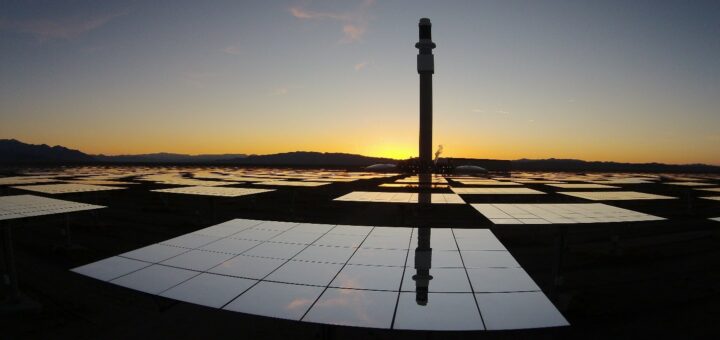The business case for CSP (Concentrated Solar Power) is difficult to establish for importer countries as well as exporter countries and its impacts. Although the impacts of the energy transition have recently emerged in the geopolitics, CSP, is almost absent from both the academic and the policy-oriented geopolitical literature. This post further discusses the context of policies for CSP deployment by renewable energy cooperation in the EU.
Currently, importer countries are not characterised by an urgent need for renewable electricity importations, as well as exporter countries have higher wholesale electricity price levels and are facing grid and interconnection issues. Hence, establishing a business case for CSP (Concentrated Solar Power) is difficult for the time being. In this context, the development of a future energy system could have a significant impact on both the prices and the demand, fostering CSP exchanges in the long term. As a result, exporter countries could achieve a more balanced national electricity system, while also enabling the provision of clean energy on-demand to systems with high RES penetration. More specifically, targeted political decisions are needed regarding support mechanisms for CSP, cross-border interconnections and the transition to a more favorable electricity market. The three main dimensions, which will define the aforementioned decisions will be (a) the EU decarbonisation goals along with the respective measures of member states, (b) the modification of electricity markets towards high RES penetration and (c) the intra-EU electricity interconnections.
In this context, the role of RES cooperation cannot be neglected. For the time horizon 2020-2030, the ‘Clean Energy for all Europeans – CE4ALL’ package adopted in May 2019 includes a new EU-wide 2030 target of 32% for the share of renewable energies in the gross final energy consumption, sets guidelines for renewable energy support schemes (and cooperation), and introduces mechanisms and instruments that will be used in case Member States miss their envisaged national RES share leading to a collective delivery gap. If a delivery gap for RES energy occurs, Member States may implement national measures to increase the RES-share or increase RES in other sectors or use cooperation mechanisms or pay into the Union financing mechanism.
RES support in the EU shall be granted by competitive procedures and provided in the form of fixed or sliding market premiums. Importantly, if a technology-neutral process would lead to suboptimal results, Member States may limit the support auction to specific technologies. This is particularly relevant for CSP projects since their deployment and competitiveness is limited by higher LCOE compared to other RES technologies, such as solar PV or onshore wind. The selling point of CSP installations is dispatchability meaning that the thermal energy generated by sunlight can be stored for several hours before it is converted into electricity. Consequently, the success of CSP projects in tendering processes depends critically on the auction design and if the energy storage option is valued.
Regarding cooperation, the new Recast RES Directive (2018/2001) foresees more support for Member States with the practical implementation and includes additional new instruments. In the post 2020 framework, CSP projects might benefit from cooperation mechanisms, however, this requires a strong interest of Member States in fostering dispatchable RES technologies. In case of statistical transfer, the off-taker country aims at low costs and has no benefit from the dispatchability. If the cooperation is based on a purely economical optimization, CSP projects will most likely not have the winning bid. This is different when electricity is physically transferred between the cooperating parties and when enabled by either joint projects or joint support schemes or open RES support auctions. In those cases, CSP with storage could contribute to an increased flexibility in the host and off-taker countries’ electricity system contributing to energy security. Furthermore, CSP expansion in Europe will likely benefit from the “Connecting Europe Facility” (CEF) program and the EU financing mechanism.
However, energy geopolitics differs widely across Member States eventually involved in CSP exchange and cooperation mechanisms. For instance, Germany and Italy have developed a special relationship with Russia, eroding in some cases EU’s cohesion in the aftermaths of the Ukraine crisis. France also imports Russian gas, but has a particular geopolitical situation given the dominance of nuclear energy in its electricity mix. Finally, Spain imports no Russian gas and has a more diversified portfolio of gas suppliers; its main supplier is Algeria, also a priority gas supplier for Italy and to a much lesser extent for France. Their energy relations and foreign policies tend to be closely linked, but have different priorities and path-dependencies. Moreover, the current European geopolitical energy landscape is still dominated by fossils, especially the gas regime. While strategists should not abandon gas geopolitics to fully shift their attention to renewables, they must include the renewable regimes in their framing of the European geopolitical energy landscape.
Although the impacts of the energy transition have only recently (but quite fast) emerged in the geopolitics, CSP, is almost absent from both the academic and the policy-oriented geopolitical literature. In addition, CSP does not even appear in governments’ energy security strategies. External energy policy remains focused on gas, pipelines and hub competition (including among Member States). Governments tend to assign RES a mercantilist strategic role: reducing energy imports and increasing exports, and promoting national industries and companies. No strategic role is assigned to CSP, and there is a general lack of knowledge of RES cooperation mechanisms and the CSP technology itself.
All things considered, the increasing ambition and target to increase the share of RES energy in the EU will lead to the expanded growth and deployment of RES technologies and thus most likely increase the use of cooperation, especially through the EU financing mechanism. The extent to which CSP will benefit from the new measures and instruments will mainly depend on the Member States’ interest to expand the flexibility of their electricity systems, hence promote a dispatchable technology and if costs for CSP can be substantially reduced in the future. If European interconnection and integrated power market goals are to be achieved, future policy initiatives should consider fostering greater understanding of these by citizens while constructively engaging with affected communities. Careful design of policy instruments is also advisable to avoid citizen rejection of both interconnections and EU’s integrated power market.
Read more on the report on Policies for CSP deployment by renewable energy cooperation in the EU here.
Read more on the report on the geopolitical context for CSP in Europe here.

This article is an output of the EU-funded MUSTEC project.
MUSTEC
The MUSTEC consortium consists of nine renowned institutions from six European countries and includes many of the most prolific researchers in the European energy policy community, with very long track records of research in European and nationally funded energy policy research projects.
MUSTEC main results are the following:- identifying the barriers holding CSP back and limiting its expansion in Europe, in the context of the energy and climate targets of 2030 and beyond,
- finding the drivers for CSP and the potential niches in which intra-European CSP trade can play an important role for the decarbonisation, stabilisation and integration of the European power system, and
- proposing concrete policy solutions to overcome the identified obstacles and create the necessary enabling conditions for European CSP growth
- Project title: Market Uptake of Solar Thermal Electricity through Cooperation (MUSTEC)
- Funding scheme: European Union Horizon 2020 Programme (EU H2020, grant agreement no. 764626)
- Duration: 3 years (1 October 2017 – 30 September 2020)
- Project coordinator: Centro de Investigaciones Energéticas, Medioambientales y Tecnológicas – CIEMAT, Spain
- Project website: http://www.mustec.eu



